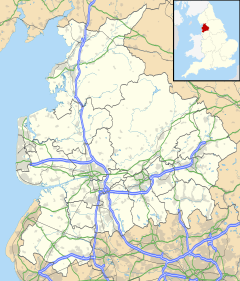Read, Lancashire facts for kids
Quick facts for kids Read |
|
|---|---|
 Looking in the direction of Simonstone, the Martholme Viaduct 1 mile (1.6 km) south-west carried the defunct Great Harwood loop line of the Lancashire and Yorkshire Railway over the River Calder |
|
| Population | 1,419 (2011) |
| OS grid reference | SD765345 |
| Civil parish |
|
| District |
|
| Shire county | |
| Region | |
| Country | England |
| Sovereign state | United Kingdom |
| Post town | BURNLEY |
| Postcode district | BB12 |
| Dialling code | 01282 |
| Police | Lancashire |
| Fire | Lancashire |
| Ambulance | North West |
| EU Parliament | North West England |
| UK Parliament |
|
Read is a village in Lancashire, England. It is about 5 miles west of Burnley. The village is also 2 miles east of Whalley. Read is located on the A671 road. This road connects Burnley and Clitheroe. In 2011, about 1,419 people lived in Read.
Contents
History of Read
What's in a Name?
The name "Read" comes from old English words. These words mean "female roe deer" and "ridge" or "headland." So, the name might describe a place with deer on a hill.
The old village started growing in the 1500s. It was built along an important old road. This road connected Whalley and Padiham.
The Battle of Read Old Bridge
A battle happened near Read Old Bridge in 1643. This was during the English Civil War. The Royalist army, loyal to the King, had about 4,000 soldiers. They were led by the Earl of Derby. This army had taken over the village of Whalley.
The Parliamentarian army had only about 400 soldiers. They were waiting near Read Old Bridge. As the Royalists came closer, they faced strong musket fire. This made them confused and they had to retreat. The Royalists then gave up Whalley. This meant that about 400 mostly untrained soldiers had defeated 4,000. This important win helped Parliament control Lancashire.
How Read is Governed
Local Government Structure
Read used to be a "township." A township was a small area within a larger church parish. The River Calder formed its border with Altham. Sabden Brook was its border with Whalley.
In 1866, Read became a "civil parish." This is a local government area. From 1894 to 1974, it was part of the Burnley Rural District. Some parts of Read moved to Sabden when it was created in 1904. Now, Read is part of the Ribble Valley borough.
Your Local Councillors
Read and Simonstone together form a "ward." A ward is an area that elects local representatives. This ward is called Read and Simonstone. It is part of the Ribble Valley Borough Council.
In 2011, about 2,573 people lived in this ward. The ward elects two councillors. Councillors are like local politicians. They help make decisions for the area. Currently, the councillors are Richard Bennett and Lesley Graves. Both of them belong to the Conservative Party.
Cool Places to See in Read
Read Hall and Its History
Read Hall and Park was the home of the Nowell family. They lived there from the 1300s. Roger Nowell was a judge in 1612. This was during the time of the Lancashire Witches. He sent them to Lancaster for trial. They were later executed.
Victoria Mill and Newtown
In the 1870s, Victoria Mill was built. It was a factory. A few houses for the workers were also built nearby. This area of Read became known as Newtown. More houses and shops were built using local stone. Today, Read has many small businesses. They offer different services for people's needs.
St John the Evangelist Church
The local church in Read is called St John the Evangelist. It was designed by Henry Ross in 1884. He was from Accrington. The tall tower on the west side of the church was added in 1911.
The Martholme Viaduct
The nearby Martholme Viaduct is about 1 mile (1.6 km) southwest of Read. A viaduct is a long bridge with many arches. This one used to carry a railway line. The railway was called the Great Harwood loop line. It was part of the Lancashire and Yorkshire Railway.
The viaduct crosses the River Calder. It is between Simonstone and Great Harwood. Sturges Meek built it between 1870 and 1877. It has ten arches, each about 65 feet (20 meters) high. The viaduct has a gentle curve.
See Also
 In Spanish: Read (Lancashire) para niños
In Spanish: Read (Lancashire) para niños


